Think Differently
Orphan RisksUnderstanding the nature of orphan risks, and how they differ from conventional risks, is a critical aspect of risk innovation thinking. The conventional risks that organizations tend to plan for are those where there is a clear and direct return on investment. On the other hand, risks associated with trust, reputation, ethical behavior, and social norms (to name just a few) tend not to be incorporated as effectively into business plans and strategies. In many cases, it’s because it’s harder to make the connection between investing in risk mitigation and short-term profits, and not necessarily because the risks are not recognized. But the results are often the same—the risks are overlooked, ignored, or simply brushed under the carpet. They are, in a very real sense, orphaned. And yet, the act of orphaning them can come with quite devastating business and social consequences.
There are rarely cut and dried approaches to handling orphan risks, yet being aware of them and developing strategies for responding to them—even if they are as simple as a commitment to not ignoring them—are important to the long-term success of enterprises.
There are three domains of risk that are central to risk innovation: Organizations and systems; unintended consequences of emerging technologies, and social and ethical factors. These capture the broad domains of risks that many conventional approaches to risk assessment and management overlook or inadequately address, and yet have the power to substantially impact operations.
Within each of these three domains, we focus risk innovation tools on six specific dimensions of orphan risks. While these are not inclusive of all risks, they provide users of our tools with an intuitive yet powerful framework for beginning to understand their specific risk landscape.
Social & Ethical Factors
Unintended Consequences of Emerging Technologies
Organizations & Systems

© 2020 Arizona Board of Regents on behalf of Arizona State University



